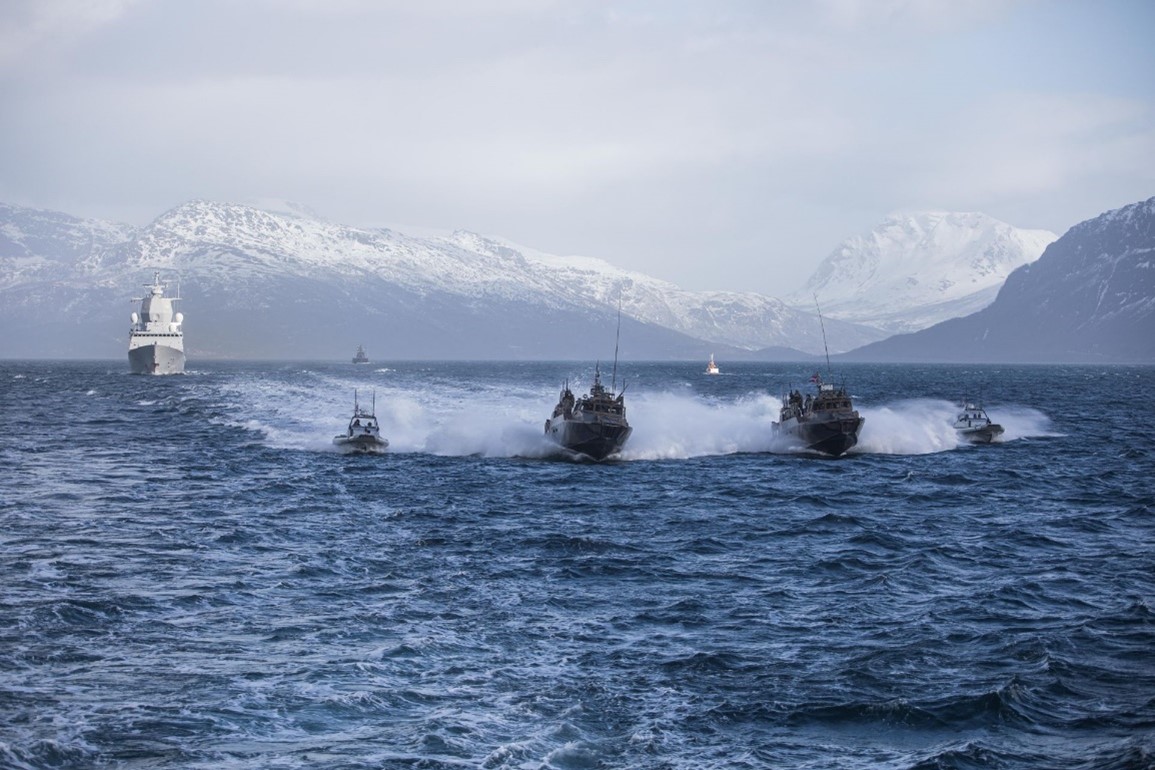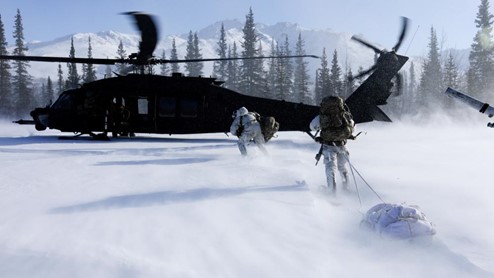THE WATCH STAFF
With Russia already occupying the Arctic and the People’s Republic of China (PRC) calling itself a “near-Arctic nation,” the United States must work toward greater persistence in the region to ensure its position as a player there, the commander of U.S. Northern Command (USNORTHCOM) has said.
This year, the U.S. military and its allies have made a number of moves in that direction. Here are some highlights:
- The military exercise Arctic Edge 2022 showcased interoperability among services and nations.
- The U.S. Navy has added new capabilities to its logistics in the high north.
- Special operators are adapting their machinery to navigate the region’s challenging terrain.
- S. ally the United Kingdom is elevating the Arctic as a national defense priority.
U.S. Air Force Gen. Glen D. VanHerck, who commands USNORTHCOM and the North American Aerospace Defense Command, told Congress in April 2021 that the U.S. should consider communications and domain awareness as security priorities for the U.S. in the Arctic, but that even more critical may be putting ships on the water. “To be persistent, you also have to be on the playing field,” VanHerck said at the time.
With the world’s longest Arctic coastline, Russia garners about a fourth of its gross domestic product from the region and has reopened and strengthened Cold War military installations that once were shuttered. The U.S. and its allies also have increased their Arctic presence, including new supply stops for nuclear-powered attack submarines at the port of Grøtsund near Tromsø, Norway.
Russia has criticized these moves while at the same time urging a resumption of meetings among the military staffs of Arctic nations to deal with disaster relief, search-and-rescue operations and other “day to day matters,” the news website Insider reported. The U.S. and its NATO allies have called off the meetings until Russia halts fighting in Ukraine.

With roots going back 50 years, Arctic Edge 2022 provided an opportunity for more than 35 units from the U.S. and Canadian armed services to undergo training in Alaska on land, sea and air. Special Operations Command North (SOCNORTH) played a heightened role in the training, gaining knowledge from native Alaskans about cold-weather techniques, practices and procedures.
Training scenarios during the February-March 2022 exercise included a series of long-range snowshoe and snow machine movements along the North Slope, Arctic Ocean and Bering Strait; exfiltration of U.S. Army Green Berets aboard MH-60 Blackhawk helicopters after days of movement through harsh environments; and free-fall jumps by U.S. Navy SEALS into areas including a mass of ice floating more than 200 miles from land in the Arctic Ocean. There, SEALS rendezvoused with the attack submarine USS Pasadena, which breached upward of 4 feet of ice as part of a concurrent U.S. Navy exercise called ICEX.
The overall pace of U.S. training in the Arctic is brisk. U.S. Navy Adm. Michael Gilday, chief of naval operations, told a House subcommittee in April 2021 that the Navy had conducted about 20 exercises and operations in the region during the previous 18 months, nearly all of them with allies and partners. (Pictured: Green Berets assigned to the 10th Special Forces Group (Airborne) head for an MH-60 Black Hawk helicopter March 14, 2022, in Wiseman, Alaska, during Arctic Edge 2022.)
Helping enable military operations in the Arctic region is an expansion of logistics services by the U.S. Navy that includes greater use of the U.K.’s Defence Munitions Centre Crombie, a small, deep-water North Sea depot on the Firth of Forth in eastern Scotland, and of Tromsø on the Norwegian Sea in far northern Norway. The move will streamline the supplying of U.S. Navy and allied ships, submarines, aircraft and expeditionary forces across the Arctic, the high north and the Baltics, according to a report by the Sicily-based Naval Supply Systems Command Fleet Logistics Center Sigonella (NAVSUP FLCSI).
In early May 2022, command personnel coordinated the loading, shipment and delivery of cargo and mail to the oiler USNS Patuxent in Crombie and to the amphibious assault ship USS Kearsarge in Tromsø. The visit to Crombie was the first for an oiler of the Patuxent’s class, Capt. Douglas S. MacKenzie, commanding officer of NAVSUP FLCSI, said in a Navy news release. Crombie, said MacKenzie, “is fast becoming a logistics center of gravity from which we can better facilitate end-to-end sustainment across Europe’s high north region.” The depot is strategically positioned to serve as a transshipment hub supporting U.S. Naval Forces Europe-Africa, the U.S. 6th Fleet and joint U.S. warfighters conducting operations with high north allies and partners.
A number of tools are in development to help forces operate in the snow and mountainous terrain of the Arctic, including a kit that transforms the military version of a side-by-side all-terrain vehicle into a weather-resistant machine with four tracks in place of wheels. This winterized MRZR Alpha LATV, for lightweight all-terrain vehicle, has been on display at springtime military exhibitions including Modern Day Marine in Washington, D.C., and the Special Operations Forces Industry Conference in Tampa, Florida. Testing of the Arctic kits is under way and production is expected to begin in 2023 by Polaris, maker of MRZR Alpha. The LATV is being built for U.S. Special Operations Command.
Nick Francis, a Polaris vice president, told Defense News, “If you can have one vehicle perform in the desert, and then modify that vehicle quickly within two to three hours, and then have it perform in the Arctic environment, you’re able to do more with one asset, so it greatly reduces the logistics burden, maintenance burden, those types of things.”
In addition, the Army is seeking to develop a larger, cold-weather all-terrain vehicle, or CATV, for use in the Arctic. The tracked vehicle would carry up to nine personnel for emergency medical evacuation, command-and-control and general-cargo transportation. The CATV would replace the small unit support vehicle, a machine with two segments joined by a hitch that moves on wheels or tracks and has been called the workhorse of the cold-weather U.S. military. Oshkosh Defense and partner ST Engineering are developing a CATV prototype, and the Army aims to acquire as many as 163 of the vehicles.
In a strategy paper presented in March 2022 to Parliament, the U.K. Ministry of Defence pledged to take a more active role in the Arctic and encouraged its NATO allies to do so. The Royal Navy will periodically conduct operations in the region alongside allies and partners, its Army will expand cold weather training, and the Royal Air Force will deploy P-8A Poseidon maritime patrol aircraft to the region while continuing to participate in NATO’s Icelandic Air Policing operation. Leading the way for the Royal Navy will be the new Future Commando Force program, made up of about 4,000 personnel with the Royal Marines. As reported by Inside, the program consists of two amphibious littoral response groups that can immediately deploy to carry out a range of tasks, from combat operations to humanitarian missions. Among their focus areas are the Arctic and the Suez Canal.
“The Arctic has historically been an area of low tension and we wish it to remain so,” British Defence Secretary Ben Wallace said in a forward to the strategy document. “However, melting sea ice in the Arctic brings threats as well as opportunities. … As the region becomes increasingly accessible, threats from elsewhere around the globe could spill over into the Arctic.”
The release of the U.K. strategy paper coincided with the final days of another Arctic military exercise, the Norway-based Cold Response 2022. The training, called off the previous two years because of the COVID-19 pandemic, involves about 30,000 troops from 27 countries in Europe and North America. NATO forms the foundation of Norway’s defense, Norwegian Armed Forces said on its website, and Cold Response provides a way for the organization to test its Response Force.
IMAGE CREDIT: STAFF SGT. ANTHONY BRYANT/U.S. ARMY

